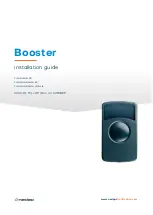
Booster | installation guide
5/25
2
Installation
2.1
Dimensions
The Booster is easily mounted to the inside of the car’s windshield by means of suction cups. Users should ensure the
visual contact between the Booster and TRANSIT reader is unobstructed with items such as stickers or metallized
windshields (see also chapter 2.3 about solar control windshields).
Note that the Booster's suction cups must be faced toward the reader to achieve maximum reading distance.
Dimension
Length
X
111 mm
4.37 "
Width
Y
65 mm
2.56 "
Height
Z
32 mm
1.26 "
Body height
H
24 mm
0.95 "
Figure 1: Booster dimensions
2.2
Temperature considerations
The Booster is designed to operate within the extreme temperature ranges, which often occur behind a vehicle’s
windshield during the winter or summer seasons (-20°C to 85°C / -4°F to +185°F). However, the personal ID card
inserted in the Booster may not be designed to withstand such temperatures and could suffer damage as a result.
Nedap recommends to remove the personal identification card when not in use.
2.3
Solar control windscreens
From 1997 onwards, several car manufacturers introduced vehicles with solar control windshields. The solar control
windshields are equipped with a metalized coating, which can block the TRANSIT signal from the Booster mounted on
the inside of the windshield of the vehicle.
Most of these windshields have a metal free zone where transponders can be mounted. The metal free zone of
metalized windshields is most often found in the middle of the windshield behind and slightly below the rear-view
mirror. In vehicles manufactured after 1998 the metal free zone should be indicated on the window.
We advise the owner to contact the local car dealer if it is not clear where the aperture is exactly positioned in a certain
vehicle and where the transponder should be mounted.
X
Y
H Z




















